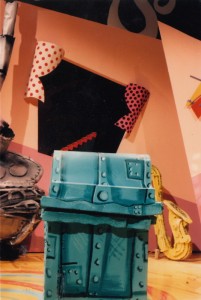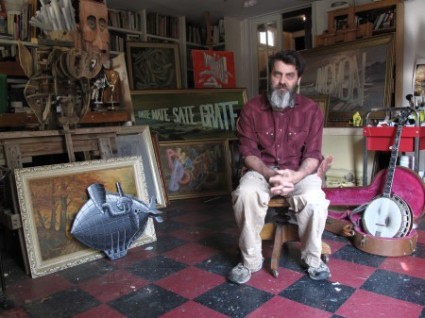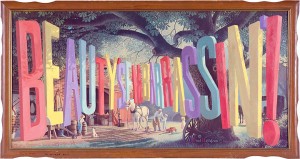Beauty is Embarrassing, Neil Berkeley’s funny, irreverent, inspiring and fascinating documentary about Tennessee-born artist Wayne White, makes its Nashville premiere at the Nashville Film Festival on Thursday April 19 at 6:30 pm. The documentary follows Wayne’s story from his humble roots as a puppeteer in Nashville to his work as one of the creative forces behind Pee-wee’s Playhouse to award-winning music video work to his current life as a notable contemporary artist. In advance of the screening Daniel Tidwell, NPT’s Vice President of Development and Marketing, caught up with Wayne to discuss art, the film and his time working at NPT (then WDCN) on Mrs. Cabobble’s Caboose.
Daniel: I watched Beauty is Embarrassing last night and was fascinated by your career path, from puppeteer to contemporary art star and now coming back around full circle, incorporating puppets into your art work. I was also blown away by how prolific you are and how naturally the art making process is for you. What keeps you motivated and interested in the art making process? Do you ever have moments when you freeze up and don’t know what to do next?
Wayne: If you have a fast car, you naturally want to take it out and let her rip. It’s as simple as that. I was lucky to be born with a fuel injected imagination. I do art because I’ve got the right motor. I’m also motivated by the fact that I can’t wait to see what this thing I’m making is going to look like and how it’s going to live in this world. I never freeze up. If nothing else, I’ll make mindless doodles until something pops out. Being blocked is just a form of self-pity and laziness.
Daniel: There’s a funny segment in the film comparing your work to Ed Ruscha’s word paintings. Do you like his work or is it just an annoying comparison at this point? Other artists who play with words that come to mind are Jenny Holzer, Lawrence Weiner and Joseph Kosuth. I have always thought the work produced by those artists was incredibly boring—has that kind of conceptual word art influenced you at all?
Daniel: Another thing that interested me about the film was the distinction that is drawn between high and low—there is a critic who talks about your work and says that at first he was reluctant to acknowledge it as “high art” because it was funny and entertaining. Your work occupies a unique place where it can appeal to everyman off the street and also to the conceptually snobbish NY or LA gallery patron. Do you consciously cater to one or the other or do those distinctions not matter when you’re working?
Wayne: I’ve been around the high and the low for thirty years. All I know is that the low likes to laugh and have a good time and the high likes to suffer and feel superior about it. I like them both, but which would you really want to hang out with? There’s also an unspoken economic class distinction. Most people in high fine arts come from upper middle class or wealthy backgrounds. They have only seen one side of life. I’m a blue collar boy from Hixson, TN, who likes Barnett Newman AND Kenny F****n’ Powers.

- Wayne White designed the sets and puppets for popular WDCN production “Mrs. Cabobble’s Caboose” (pictured here). Photo courtesy Wayne White
Daniel: The first time I became aware of your work was when I bought Lambchop’s Nixon album, then one day stumbled across Western Project’s website and made the connection with your television work on Pee Wee’s Playhouse and your art. Soon after someone at Nashville Public Television, where I work, mentioned the kids show that you used to work on, Mrs. Cabobble’s Caboose. What was it like working at WDCN doing educational TV for kids?
Wayne: Mrs. Cabobble’s Caboose was my first professional puppet and set design job. It was a very important stepping stone. My MCC portfolio got me The Pee-wee job. I didn’t once worry about the educational aspects of it. I was only out to have as much fun as I could with the resources available to me at WDCN and create something cool looking.
Daniel: It’s rare to find an insightful documentary about a visual artist, and rarer to find one that’s entertaining to watch. I found the documentary and your approach to art as play to be incredibly inspiring. Do you have any advice to aspiring young artists?
Wayne: Never give up. Don’t listen to your friends or parents if they tell you to wise up and stop dreaming your life away. The world likes reason and conformity. The artist creates his own world and goes down fighting. If you’re not ready to be a soldier, then forget it.
Daniel: There’s a segment in the documentary where your friend who teaches at the Webb School talks about how you left for New York City and he stayed behind in the country. Do you think it’s still necessary to move to a big city like New York or LA to find yourself as an artist, given the accessibility of art of every kind on the internet?
Wayne: When I was coming up, you had to go where the action was. Today, the computer has changed all that. You can stay connected wherever you are. But I still think it’s important to leave the safety of home and see the world. It makes you a better person and artist. It also helps your spirit to be in a real, not virtual, community of artists. It’s the difference between XBox baseball and real baseball. Get in the game!
Daniel: What do you hope that viewers will take away from the film?
Wayne: I simply want viewers to be entertained for 90 minutes. That ain’t easy. Try it sometime. If they come away inspired, I’ll shed a tear of joy for all my fellow weirdos.
Interview conducted and edited by Daniel Tidwell.

